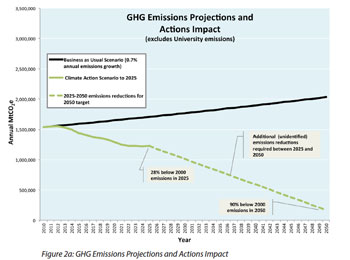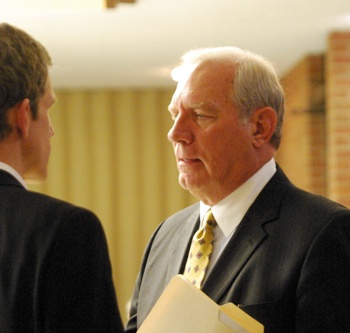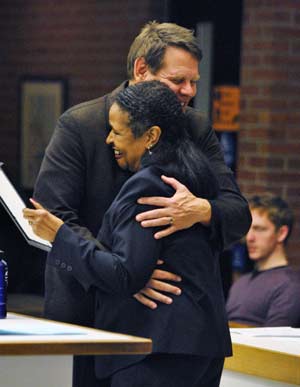Ann Arbor city council meeting (Dec. 17, 2012): The agenda for the council’s final regular meeting of the year was relatively light, but was weighted toward “green” issues – including parks and more general environmental items.

Chart showing projected greenhouse gas emissions if the city of Ann Arbor does nothing, compared to enacting steps outlined in the climate action plan, which was adopted by the city council at its Dec. 17, 2012 meeting.
The council approved two grant applications for future development of at least part of the city-owned property at 721 N. Main St. as a park. It’s seen as an element of a future Allen Creek greenway that would arc northward along the railroad tracks, starting from the East Stadium bridges to the Huron River. The applications were for unspecified amounts from the Michigan Natural Resources Trust Fund (MNRTF) and the Washtenaw County parks & recreation Connecting Communities program. Last year the city received two $300,000 grants from the MNRTF – for the future skatepark at Veterans Memorial Park, and for renovations to the boating facilities at Gallup Park.
The current grant applications came in the general context of an initial recommendation made by a council-appointed task force that has been meeting since the summer. That task force has a much broader geographic charge, which includes the North Main corridor, extending eastward to the Huron River and over to the MichCon property. The task force is due to make recommendations to the council on that broader area by the summer of 2013. However, the group was asked to weigh-in specifically on the 721 N. Main property by the end of this year – because of the grant application deadlines.
The North Main task force had been appointed at the same May 7, 2012 meeting when the council had heard from representatives of 555 Nonprofit Gallery and Studios on the physical survey work necessary for another city-owned property – at 415 W. Washington. At least part of that property is also envisioned as part of a future Allen Creek greenway. After appropriating $50,000 for physical testing at its July 16, 2012 meeting, the council on Dec. 17 allocated another $32,583 after bids came back.
In addition to green space, the council’s Dec. 17 agenda included two “green” resolutions – one that adopted a climate action plan and the other calling on the U.S. Environmental Protection Agency to enforce the Clean Air Act. Ann Arbor’s climate action plan calls for a reduction in greenhouse gas (GHG) emissions of 8% by 2015, 25% by 2025, and 90% by 2050. The reductions are compared to baseline levels measured in the year 2000. The action steps identified in the climate action plan are divided into four main categories: energy and buildings; land use and access; resource management; community and health. Those categories align with the city’s sustainability framework. The plan is also coordinated with a similar effort by the University of Michigan.
Other business handled by the council included another request to the Washtenaw County water resources commissioner’s office in connection with stormwater infrastructure for a street reconstruction project. The petition requested an application for $1.4 million in low-interest loans for a three-year project in the Platt-Packard neighborhood. Also connected to bricks-and-mortar infrastructure was an additional allocation of about $148,000 for the 2012 sidewalk repair and ramp installation program – the first year of a five-year cycle, corresponding to a millage approved by voters in 2011. The total mount of the 2012 sidewalk program was about $965,000.
The council also gave its recommendation to grant a micro brewer license to Biercamp Artisan Sausage & Jerky, a retail shop located at 1643 S. State St.
Initial approval was given by the council for a revision to the city’s ordinance regulating parking on front lawns. The change will make it easier to make arrangements for events other than University of Michigan football games.
And the council approved a $90,000 project budget that will allow for documents to be submitted digitally to the planning and development department. The project includes a public kiosk for reviewing plans.
The council also heard its typical range of public commentary, with topics including pedestrian safety, towing, and Palestinian rights. [Full Story]






